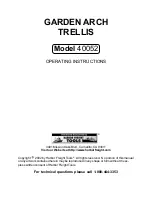
PhaseStation 53100A User’s Manual V1.04 25-Apr-2022
27
Furthermore, even when using the best standards, distribution amps and double-shielded cables, it’s
almost impossible to build a large clock distribution network that’s free of environmental spurs. As a
result, you should consider using a standalone low-noise OCXO – or even better, two of them -- for
phase noise and AM noise measurements.
Unlike most other stability and noise analyzers, the 53100A can work with any reference whose
frequency lies within its specified RF carrier range (1-200 MHz), regardless of the input frequency from
the device under test (DUT).
Frequency readings and phase noise levels are always referred to the
frequency at the INPUT jack.
For example, if your 10 MHz DUT’s phase noise when measured with a 5 MHz reference is -160 dBc/Hz
at 10 kHz and its Allan deviation is 3E-12 at t=10s, you will still measure -160 dBc/Hz and ADEV=3E-12 if
you switch to a 10 MHz reference, or one at any other frequency.
One complication, however, is the need to handicap the reference’s phase noise and FM/PM spur
amplitudes by 20*log10(F
DUT
/F
REF
) dB when the DUT and reference frequencies differ. This is the same
effect that classically applies when a signal undergoes frequency multiplication or division. The effective
phase noise and spur performance of the reference source would be 6 dB worse in the example above
where a 5 MHz reference is used to characterize a 10 MHz device. Likewise, the reference’s long-term
stability characteristics (e.g., Allan deviation) would be degraded by a factor of 2. Ideally, the phase
noise of your reference after any applicable 20*log10(F
DUT
/F
REF
) correction should be at least 8-10 dB
lower than the expected performance of the DUT at the offsets of interest. The reference’s phase noise
will not affect the measurement to any great extent as long as this margin is maintained.
Bear in mind that lower-frequency crystal oscillators will usually exhibit better close-in noise than those
at higher frequencies, even when the 20*log(N) rule is taken into consideration. This is a consequence
of the physical properties of the crystals themselves. For example, the highest-quality 5 and 10 MHz
OCXOs on the market can perform at levels below -130 dBc/Hz at 1 Hz from the carrier. These
oscillators make superior references for HF frequency stability and close-in noise measurement, easily
outperforming the best VHF oscillators. But at the same time, they will be less effective than low-noise
VHF oscillators as references for broadband noise measurement of VHF sources. Low-frequency
reference oscillators have no inherent advantages at offsets beyond a few kHz where crystal Q no longer
dominates, and the 20*log(N) principle will work against them when measuring higher-frequency DUTs.
An additional consideration when specifying reference oscillators is that industry-standard frequencies
such as 5, 10, and 100 MHz benefit from a larger selection of crystals at the factory. Within a given
product line, oscillators at unusual frequencies will rarely outperform units manufactured at standard
frequencies.
3
This being said, it’s sometimes useful to measure the phase noise or stability of a DUT by using an identical device as the reference. In such a
case, where the phase noise of the reference and DUT is presumed to be identical but uncorrelated, the resulting PN graph will be 3 dB too
high, while Allan deviation and related measurements will be artificially elevated by a factor of sqrt(2). You can use the
Rescale Phase
field in
TimeLab’s
Edit
→
Trace properties
dialog to correct the ADEV of two identical devices by scaling the phase data by 0.707. Similarly, the phase
noise may be corrected by entering -3 in the
PN Gain
field to lower the trace by 3 dB.
Содержание PHASE STATION 53100A
Страница 1: ...TM 53100A Phase Noise Test Set User s Manual Revision 1 04 April 25 2022...
Страница 16: ...PhaseStation 53100A User s Manual V1 04 25 Apr 2022 16...
Страница 18: ...PhaseStation 53100A User s Manual V1 04 25 Apr 2022 18...
Страница 20: ...PhaseStation 53100A User s Manual V1 04 25 Apr 2022 20...
Страница 30: ...PhaseStation 53100A User s Manual V1 04 25 Apr 2022 30...
Страница 36: ...PhaseStation 53100A User s Manual V1 04 25 Apr 2022 36...
Страница 42: ...PhaseStation 53100A User s Manual V1 04 25 Apr 2022 42...
Страница 64: ...PhaseStation 53100A User s Manual V1 04 25 Apr 2022 64...
Страница 74: ...PhaseStation 53100A User s Manual V1 04 25 Apr 2022 74...
Страница 104: ...PhaseStation 53100A User s Manual V1 04 25 Apr 2022 104...
Страница 116: ...PhaseStation 53100A User s Manual V1 04 25 Apr 2022 116...
Страница 122: ...PhaseStation 53100A User s Manual V1 04 25 Apr 2022 122...
Страница 130: ...PhaseStation 53100A User s Manual V1 04 25 Apr 2022 130...
Страница 140: ...PhaseStation 53100A User s Manual V1 04 25 Apr 2022 140...
Страница 143: ...PhaseStation 53100A User s Manual V1 04 25 Apr 2022 143 Figure 66 5 MHz residual phase noise and AM noise...
Страница 214: ...PhaseStation 53100A User s Manual V1 04 25 Apr 2022 214...
Страница 215: ...PhaseStation 53100A User s Manual V1 04 25 Apr 2022 215 Appendix Legal and regulatory notices...
















































